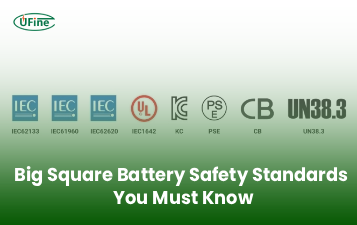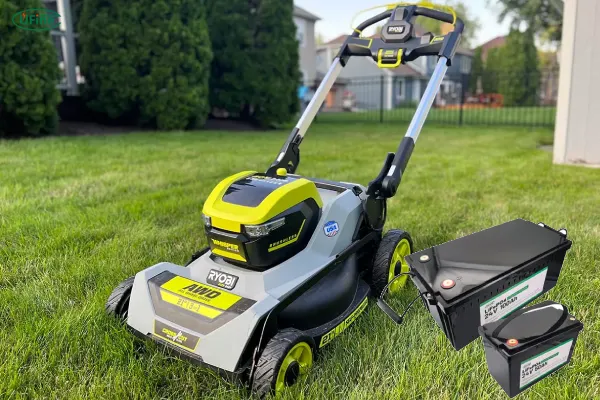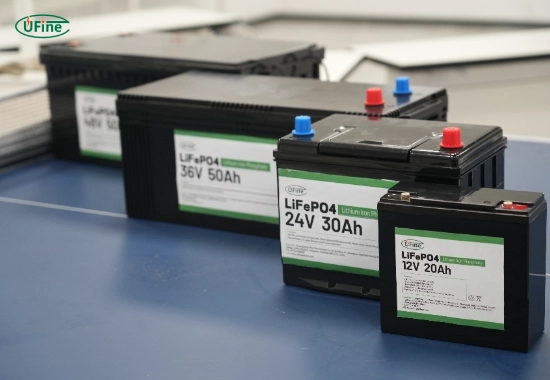
- Part 1. What is a lawn mower battery?
- Part 2. How many volts is a lawn mower battery?
- Part 3. Why does battery voltage matter?
- Part 4. How to check the voltage of your lawn mower battery?
- Part 5. Types of lawn mower batteries by voltage
- Part 6. How to choose the right voltage battery for your mower?
- Part 7. Can you use a car battery in a lawn mower?
- Part 8. How to safely charge a lawn mower battery?
- Part 9. Signs your lawn mower battery is failing
- Part 10. How to extend your lawn mower battery life?
- Part 11. FAQs about lawn mower battery voltage
If you’re wondering how many volts a lawn mower battery is, the answer depends on the type of mower you own. Most traditional riding lawn mowers use a 12-volt battery, while some older models and specialty equipment may operate with a 6-volt battery. Modern cordless electric mowers often use lithium-ion batteries ranging from 20V to 80V.
Understanding your mower’s battery voltage is crucial for proper maintenance, optimal performance, and machine longevity. In this comprehensive guide, we’ll explore the different types of mower batteries, how to determine their voltage, how they function, and how to take care of them effectively.
Look at everything you need to know about lawn mower battery voltage.
Part 1. What is a lawn mower battery?
A lawn mower battery is a rechargeable power source that provides the electrical energy needed to start the mower and operate any additional electronic components. In gasoline-powered mowers, the battery powers the starter motor and ignition system. In electric mowers, the battery supplies energy to the motor that drives the blades and wheels.
There are two main types of lawn mower batteries:
- Lead-acid batteries: These are similar to car batteries and are commonly found in riding mowers.
- Lithium-ion batteries: These are used in cordless electric mowers and are lighter, more energy-efficient, and longer-lasting.
Regardless of the type, all batteries have a specific voltage rating, determining how much electrical power they can deliver.
Part 2. How many volts is a lawn mower battery?
Most lawn mower batteries are 12 volts. This is the standard for modern riding mowers and lawn tractors. However, not all lawn mowers use the same voltage. Here’s a breakdown:
- Riding mowers and lawn tractors: Almost always use 12-volt lead-acid batteries.
- Older riding mowers: Some models may use 6-volt batteries, especially those built before the 1980s.
- Cordless electric mowers: Use lithium-ion batteries that range from 20V to 80V, depending on the make and model.
- Push mowers with electric start (gas-powered): Usually use 12V batteries to power the starter motor.
Quick Reference Table
| Lawn Mower Type | Common Battery Voltage |
|---|---|
| Riding Mower (modern) | 12V |
| Vintage Riding Mower | 6V |
| Cordless Electric Push Mower | 20V-80V (Li-ion) |
| Gas Push Mower with Start | 12V |
Part 3. Why does battery voltage matter?
Voltage determines the electrical potential of the battery. Using the correct voltage ensures your mower starts reliably and runs efficiently. Using the wrong voltage can lead to:
- Failure to start
- Reduced performance
- Permanent damage to the mower’s electrical system
- Battery overheating or failure
If you try to start a mower designed for 12V with a 6V battery, it likely won’t crank at all. On the other hand, using an 18V battery instead of a 12V system may overload and fry the circuitry.
In short, voltage compatibility is non-negotiable.
Part 4. How to check the voltage of your lawn mower battery?
To determine the voltage of your lawn mower battery, try these methods:
1. Read the label
Most batteries have a label that indicates the voltage, amp-hour rating, and battery type.
2. Use a multimeter
A digital multimeter is the most accurate way to test voltage. Here’s how:
- Set the multimeter to DC volts.
- Connect the red probe to the battery’s positive terminal and the black probe to the negative.
- A fully charged 12V battery should read between 12.6V and 12.8V.
- A fully charged 6V battery should read around 6.3V.
3. Check the cell count
Lead-acid batteries have internal cells, each producing around 2.1 volts. You can estimate voltage by counting the fill caps (if visible):
- 3 cells = 6V
- 6 cells = 12V
Part 5. Types of lawn mower batteries by voltage
Look more closely at battery types categorized by voltage and use case.
6-Volt Batteries
- Mostly found in outdated or vintage mowers
- Lower power output
- Harder to find replacements
- Lesser cold cranking amps (CCA)
12-Volt Lead-Acid Batteries
- Standard in modern riding mowers and tractors
- Available in flooded, AGM (Absorbent Glass Mat), and gel types
- Affordable and easy to replace
- Requires regular maintenance (especially flooded types)
Lithium-Ion Batteries (20V-80V)
- Common in cordless electric push mowers
- Lightweight and efficient
- Quick recharging with low maintenance
- Long lifespan compared to lead-acid
- Voltage depends on brand: e.g., Greenworks (40V, 60V, 80V), EGO (56V), Ryobi (40V)
Part 6. How to choose the right voltage battery for your mower?
Choosing the right battery voltage involves a few key steps:
- Check your user manual: Always the most reliable source.
- Look at the old battery: Match the voltage, size, and terminal configuration.
- Consider your mower type: Electric mowers need high-voltage lithium-ion packs, while gas-powered models usually require 12V lead-acid.
- Think about weather: Cold climates may require higher CCA ratings for better starts.
Never guess the voltage. Using an incorrect battery can void the warranty and cause irreversible damage.
Part 7. Can you use a car battery in a lawn mower?
Technically, car and lawn mower batteries are 12V, but they are not interchangeable.
Car batteries are:
- Larger and heavier
- Designed for high cranking amps
- Built for automotive alternators
Lawn mower batteries are:
- Compact and lighter
- Designed for seasonal use
- Require lower CCA
Using a car battery in your mower could damage the starter or stress the electrical system. It’s best to use a dedicated lawn mower battery.
Part 8. How to safely charge a lawn mower battery?
Charging a battery properly will extend its life and improve performance.
For Lead-Acid Batteries (6V or 12V):
- Use a smart charger that matches the battery voltage.
- Connect red to positive (+), black to negative (-).
- Charge in a dry, ventilated area.
- Avoid overcharging. Use an automatic shut-off charger if possible.
For Lithium-Ion Batteries:
- Only use the manufacturer’s supplied charger.
- Avoid heat and moisture during charging.
- Do not continue charging once complete.
Important: Overcharging any battery can lead to overheating, swelling, or leaks.
Part 9. Signs your lawn mower battery is failing
Watch for these signs that your battery is losing voltage or nearing the end of its life:
- Mower cranks slowly or not at all
- Battery doesn’t hold a charge
- You need to jumpstart the mower frequently
- Visible corrosion or acid leaks
- Swollen or cracked battery casing
If your battery is more than 3-5 years old and showing any symptoms, it’s likely time to replace it.
Part 10. How to extend your lawn mower battery life?
With proper care, you can maximize the lifespan of your mower battery. Here’s how:
- Charge regularly during the mowing season.
- Store indoors during winter or cold months.
- Clean terminals to prevent corrosion.
- Use a battery maintainer (also called a trickle charger) during off-season.
- Avoid deep discharges, especially with lithium-ion batteries.
For lead-acid units, check fluid levels if your battery is not sealed. Add distilled water when necessary.
Part 11. FAQs about lawn mower battery voltage
How many volts is a riding lawn mower battery?
Most riding lawn mowers use a 12-volt battery.
Can I use a car battery in my lawn mower?
Although both may be 12V, car batteries are unsuitable for lawn mowers due to size and power differences.
How do I test my lawn mower battery voltage?
A digital multimeter measures the voltage between terminals. A fully charged 12V battery should read 12.6- 12.8V.
What happens if I use the wrong voltage battery?
Using the wrong voltage can cause starter failure, electrical damage, or even fire hazards in extreme cases.
How long do lawn mower batteries last?
Typically, 3-5 years for lead-acid and 5-7 years for lithium-ion, depending on maintenance and usage.
Related Tags:
More Articles

Big Square Battery Safety Standards You Must Know
Learn key safety standards for big square batteries to avoid fire risks, shipping delays, and compliance issues in EV, industrial, and energy storage projects.
Big Square Battery Applications in Solar & Industrial Equipment
Big square batteries deliver high capacity, stable output, and long life for solar, industrial, and backup power. Explore key uses and advantages.
Big Square Battery vs Cylindrical Battery: Complete 2025 Guide for EVs, ESS & Industrial Devices
Choosing the right battery is key for designers and engineers. Compare big square vs cylindrical batteries to find the best fit for your application.
How to Choose the Right Big Square Battery for Your Device?
If you’re choosing a big square battery for EVs, solar, or mobility devices, this guide helps you pick the right solution for real-world needs.
Big Square Battery Complete Guide: Types, Uses & Buying Tips
If you are choosing a big square lithium battery for EVs, solar, RVs, or AGVs, this guide helps you select the right NMC, LFP, or LTO solution with examples.




